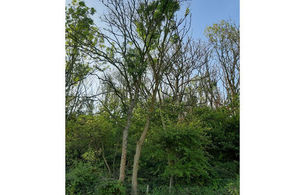
An infected ash tree at Cinque Ports Training Area, where a similar, smaller-scale felling programme took place in 2018. Copyright Landmarc Support Services.
To protect the future of uninfected ash trees, the Defence Infrastructure Organisation (DIO), together with its strategic partner, Landmarc Support Services (Landmarc), is carrying out a tree-felling clearance scheme to remove infected trees, beginning in early 2020.
There is no cure or treatment for the disease and over time infected trees will weaken, causing branches to fall and trees to eventually collapse and die. This presents a significant health and safety risk, especially alongside roads, public rights of way and woodland areas used by the public for recreation activities and soldiers for training.
Infection can lead to the death of young trees in just two to three years and of mature trees within three to five years. Approximately 14,000 trees across 250 locations have been affected by the disease on the Salisbury Plain Training Area.
To protect the public and estate users, DIO foresters and ecologists are working with Landmarc, the Forestry Commission and Natural England to inspect and remove infected trees. A replanting scheme will also take place to replace lost trees in accordance with the requirements of the felling licences. The DIO and Landmarc are also working closely with Wiltshire Council to manage the effect on roads and any potential road closures.
Jeremy Kalkowski, DIO's Senior Forester, said:
We are working closely with Landmarc, the Forestry Commission and Natural England to protect the public and estate users, remove hazards and reduce the impact on the wider environment. Where possible, we will use this as an opportunity to enrich and improve our woodland resource.
We are felling the minimum number of trees to reduce risk to an acceptable level and only in areas where there is a clear risk of harm to people.
The MOD takes conservation very seriously and we are committed to completing a replanting scheme to replace felled ash trees with a range of native species trees.
Chris Sorensen, South West Woodland Resilience Officer, from the Forestry Commission said:
Since ash dieback was identified in 2012, we have been working with a range of stakeholders and have invested more than £37 million into tree health research, including funding research into the biology and pathology of the disease.
We encourage all owners of woodland to think strategically about the management of their ash trees and adopt best practice to help reduce the impact of the disease.
The Defence Infrastructure Organisation consulted with us and agreed a plan of action to tackle this damaging tree disease which includes the commencement of felling operations in the interests of public safety.
Judith Peachey, Landmarc's Forestry Harvesting and Marketing and Arboriculture Advisor said:
Sadly, the felling of trees with Ash Dieback is a necessary step to protect the public and all other training estate users. We would therefore like to take this opportunity to thank our local communities for their support by adhering to any site safety signs and not entering any areas where forestry work is taking place. Trees are only being felled where we must and unaffected trees will remain to support the biodiversity associated with ash.
The work will take place in phases and should be completed in approximately 3 years, with tree health surveying and monitoring continuing once felling is complete. The first phase of felling will target Ashdown Copse and along the A345, and will run until the end of March 2020, when work will stop to protect nesting birds. Phase two will begin in September 2020 to continue work at Ashdown Copse, as well as other locations where Ash Dieback has been identified including Erlestoke, Everleigh, Heytesbury, Warminster and along neighbouring roadsides.
Areas where work is taking place will be closed to the public for safety reasons. Areas available for recreation will be signed as open to the public.
F






